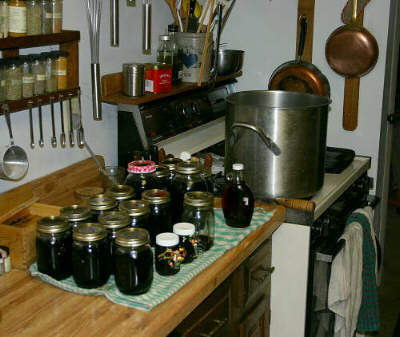MAPLE SYRUP
Jack Schmidling Productions, Inc.
Marengo Illinois
MOST RECENT PHOTOS PHOTO INDEX HOME PAGE
New SLIDE SHOW New
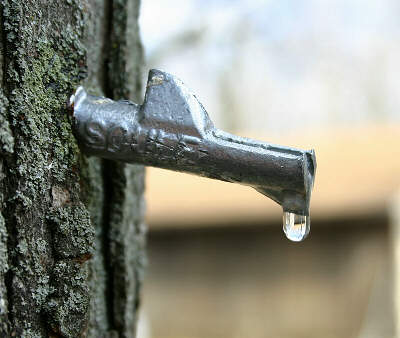
MAPLE SYRUP
It's that time of year again. We have made maple syrup and sometimes wine every year since we have lived out here. This year we tapped 23 Silver Maple trees and just started collecting the sap.
This nifty gadget is called a spile and fits into a hole drilled into the tree. The hook on top allows a bucket or sap sack to be hung directly from it.
The tree end is tapered so tapping with a hammer makes a leak-proof seal.
The rate of drip depends on the weather conditions and varies from zero to about one per second.
.
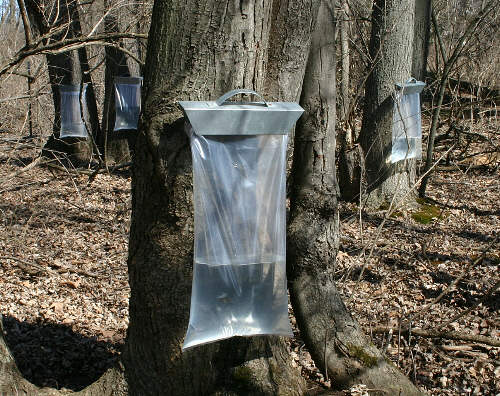
The area where trees are tapped is known as the sugar bush and this photo shows a small portion of ours.
We use a commercial "Sap Sack" to collect the sap after trying many on hand methods that are more pain than fun. These work very well and hold about 3 gallons of sap.
The sap starts to run as soon as above freezing days occur and stops if it stays above freezing for more than a day. It also stops at night when it freezes but then resumes in the morning if it warms up again.
The sap is simply water containing about 3% sugar that was produced by the leaves in Fall and stored in the roots. In Spring this sugar is required by the new buds for development. When the new leaves start photosynthesizing and producing sugar, the flow stops completely.
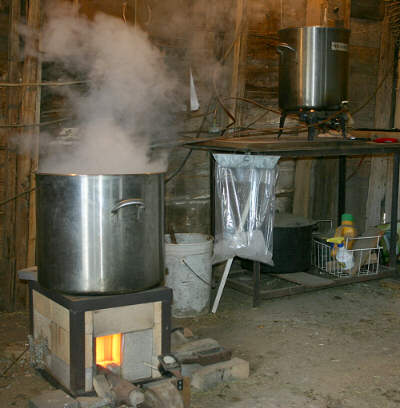
MAPLE SYRUP II
Last week we showed how we collect the sap and this week we are boiling it down to syrup.
The kettle on the right is the pre-heater and collector. The bags of sap are poured into this kettle as they are collected. It is held in the kettle to not only begin heating but to allow it to flow into the boiling kettle on the left at a controlled rate.
There is a length of copper tubing between the kettles and a valve on the pre-heat kettle to control the flow. The idea is to never allow the boiler to stop boiling and to match the inflow with the evaporation rate. There is only about 5 inches of boiling sap in the kettle so that it can be brought quickly to a boil each morning.
Traditionally, a much shallower boiler is used but this one serves also as a brew kettle for beer and the other is the mash tun. The furnace can also serve as a foundry melting furnace by re-arranging a few fire bricks.
.
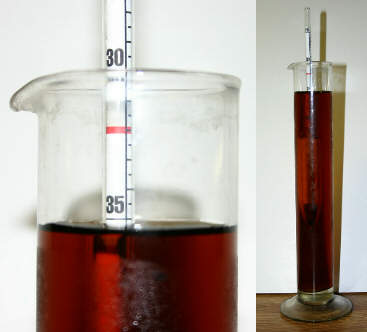
In the first picture, we saw a drop of sap at the end of the spile which looks just like water. In fact, it is water with 3% maple sugar. Boiling off the water concentrates the sap to whatever sugar content we want. Table syrup should be about 67%. A lower concentration is too runny and will not keep well. A higher concentration will crystallize out and produce lumps of hard sugar on the bottom which can not be poured as syrup.
During the boil down, the syrup is tested with a hydrometer which will float at a specific level determined by the sugar content. Syrup producers use a scale known as Baume and 36 on the Baume scale equals 67% sugar.
We have also made maple wine and in this case the boiling is halted at about 10% sugar to produce a 12% wine.
